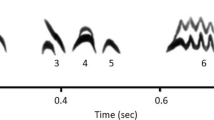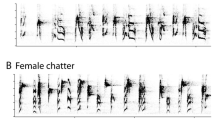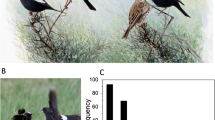Abstract
In many species, females' behavior appears to be influenced by that of other females, particularly regarding mate choice. Females theoretically can reduce the costs associated with independent male assessment by observing conspecifics. Studies of brown-headed cowbirds suggest that females pay attention to other females' behavior. Group-housed females modify their song preferences, whereas females housed in pairs do not. What information is available to females in a group environment? To address this question, we studied two groups of juvenile (i.e. hatch-year birds) and adult female cowbirds in a naturalistic group setting. We used a longitudinal ABA design, consecutively introducing and removing males that differed in age, amount of song production and stage of song development, to isolate the male characteristics that related to changes in female behavior. Juvenile and adult females assorted by age class when singing adult males were in the aviary, but not when singing juveniles or silent males of any age class were in the aviary. Results from playback tests confirmed that adult male song alone influenced female age class assortment. Videotape analysis from playback tests revealed that females also wing stroked in response to male song. Other females sometimes approached females who wing stroked and observed them. We hypothesize that group-level changes in social organization and individual females' responses can serve as visual signals for other individuals.


Similar content being viewed by others
References
Agrawal AF (2001) The evolutionary consequences of mate copying on male traits. Behav Ecol Sociobiol 51:33–40
Altmann J (1974) Observational study of behavior: sampling methods. Behaviour 49:227–267
Baptista LF, Trail PW, DeWolfe BB, Morton ML (1993) Singing and its functions in female white-crowned sparrows. Anim Behav 46:511–524
Cassini MH (2000) A model on female breeding dispersion and the reproductive systems of Pinnipeds. Behav Proc 51:93–99
Doligez B, Danchin E, Clobert J (2002) Public information and breeding habitat selection in a wild bird population. Science 297:1168–1170
Doutrelant C, McGregor PK (2000) Eavesdropping and mate choice in female fighting fish. Behaviour 137:1655–1669.
Dufty AM Jr (1986). Singing and the establishment and maintenance of dominance hierarchies in captive brown-headed cowbirds. Behav Ecol Sociobiol 19:49–55.
Dugatkin LA (1992) Sexual selection and imitation: Females copy the mate choice of others: Am Nat 139:1384–1389
Dugatkin LA, Godin JGJ (1993) Female mate copying in the guppy (Poecilia reticulata): age-dependent effects. Behav Ecol 4:289–292
Earley RL, Dugatkin LA (2002) Eavesdropping on visual cues in green swordtail (Xiphophorus helleri) fights: a case for networking. Proc R Soc Lond Ser B 269:943–952
Freeberg TM (1998) The cultural transmisssion of courtship patterns in cowbirds, Molothrus ater. Anim Behav 56:1063–1073.
Freeberg TM (1999) Spatial associations provide a context for social learning of courtship patterns in brown-headed cowbirds (Molothrus ater). J Comp Psychol 113:327–332
Freeburg TM, Duncan SD, Kast TL, Endstrom DA (1999) Cultural influences on female mate choices: an experimental test in cowbirds, Molotrus ater. Anim Behav 57:421-427
Gibson RM, Höglund J (1992) Copying and sexual selection. Trends Ecol Evol 7:229–231
Gibson RM, Bradbury JW, Vehrencamp SL (1991) Mate choice in lekking sage grouse revisited: The roles of vocal display, female site fidelity, and copying. Behav Ecol 2:165–180
Grant JWA, Green LD (1996) Mate copying versus preference for actively courting males by female Japanese medaka. Behav Ecol 7:165–167
Hoglund J, Alatalo RV, Gibson RM, Lundberg A (1995) Mate-choice copying in black grouse. Anim Behav 49:1627–1633
Jennions MD, Petrie M (1997) Variation in mate choice and mating preferences: a review of causes and consequences. Am Nat 72:283–327
King AP, West MJ (1983) Female perception of cowbird song: a closed developmental program. Dev Psychobiol 16:335–342
King, AP, West, MJ (1988) Searching for the functional origins of song in eastern brown-headed cowbirds, Molothrus ater ater. Anim Behav 36:1575–1588
King AP, West MJ (1989) Presence of female cowbirds (Molothrus ater ater) affects vocal improvisation in males. J Comp Psychol 103:39–44
King AP, West MJ, White DJ (2002) The presumption of sociality: Social learning in diverse contexts in brown-headed cowbirds (Molothrus ater). J Comp Psychol 116:173–181
Losey GS, Stanton FG, Telecky TM, Tyler WA III, the Zoology 691 graduate seminar class (1986) Copying others, an evolutionarily stable strategy for mate choice: a model. Am Nat 128:653–664
McComb K, Clutton-Brock T (1994) Is mate choice copying or aggregation responsible for skewed distributions of females on leks. Proc R Soc LondSer B 255:13–19
Mennill DJ, Ratcliffe LM, Boag PT (2002) Female eavesdropping on male song contests in songbirds. Science 2996:873
Naguib M, Fichtel C, Todt D (1999) Nightingales respond more strongly to vocal leaders of simulated dyadic interactions. Proc R Soc Lond Ser B 266:537–542
Nordell SE, Valone TJ (1998) Mate choice copying as public information. Ecol Lett 1:74–76
Nowicki S, Searcy BA, Peters S (2002). Quality of song learning affects female response to male bird song. Proc R Soc Lond Ser B 269:1949–1954
Oliveira RF, McGregor PK, Latruffe C (1998) Know thine enemy: fighting fish gather information from observing conspecific interactions. Proc R Soc Lond Ser B 265:1045–1049
Otter K, McGregor PK, Terry AMR, Burford FRL, Peake, TM, Dabelsteen T (1999) Do female great tits (Parus major) assess males by eavesdropping? A field study using interactive song playback. Proc R Soc Lond Ser B 266:1305–1309
Peake TM, Terry AMR, McGregor PK, Dabelsteen T (2001) Male great tits eavesdrop on simulated male-to-male vocal interactions. Proc R Soc Lond Ser B 268:1183–1187
Pruett-Jones S (1992) Independent versus nonindependent mate choice: do females copy each other? Am Nat 140:1000–1009
Searcy WA, Nowicki S, Hughes M, Peters S (2002) Geographic song discrimination in relation to dispersal distances in song sparrows. Am Nat 159:221–230
Selander RK, Giller D (1960) First year plumages of the brown-headed cowbird and red-winged blackbird. Condor 62:202–214
Shuster SM, Wade MJ (1991) Female copying and sexual selection in a marine isopod crustacean Paracerceis sculpta: Anim Behav 41:1071–1078
Sirot E (2001) Mate choice copying by females: the advantages of a prudent strategy. J Evol Biol 14:418–423
Slagsvold T, Viljugrein H (1999) Mate choice copying versus preference for actively displaying males by female pied flycatchers. Anim Behav 57:679–686
Smith VA, King AP, West MJ (2000) A role of her own: Female cowbird influences on vocal development. Anim Behav 60:599–609
Smith VA, King AP, West MJ (2002) The context of social learning in brown headed cowbirds: association patterns in a captive flock. Anim Behav 63:23–35
Stohr S (1998) Evolution of mate choice copying: a dynamic model. Anim Behav 55:893–903
Templeton JJ, Giraldeau LA (1996) Vicarious sampling: the use of personal and public information by starlings foraging in a simply patchy environment. Behav Ecol Sociobiol 38:105–114
Valone TJ (1989) Group foraging, public information, and patch estimation. Oikos 56:357–363
Valone TJ (1996) Food-associated calls as public information about patch quality. Oikos 77:153–157
Wade MJ, Pruett-Jones SG (1990) Female copying increases the variance in male mating success: Proc Natl Acad Sci USA 87:5749–5753
West MJ, King AP (1988a) Female visual displays affect the development of male song in the cowbird. Nature 334:244–246
West MJ, King AP (1988b) Vocalizations of juvenile cowbirds (Molothrus ater ater) evoke copulatory responses from females. Dev Psychobiol 21:543–552
West MJ, King AP, Freeberg TM (1996) Social malleability in cowbirds: new measures reveal new evidence of plasticity in the Eastern subspecies (Molothrus ater ater). J Comp Psychol 110:15–26
West MJ, King, AP, Freeberg, TM (1998) Dual signaling during mating in brown-headed cowbirds (Molothrus ater, Family Emberizidae/Icterinae). Ethology 104:250–267
West MJ, White DJ, King AP 2002 Female brown-headed cowbirds' (Molothrus ater) organization and behaviour reflects male social dynamics. Anim Behav (in press)
Westneat DF, Walters A, McCarthy TM, Hatch MI, Hein WK (2000) Alternative mechanisms of nonindependent mate choice. Anim Behav 59:467–476
White DJ, Galef BJ, Jr. (1999) Mate choice copying and conspecific cueing in Japanese quail, Coturnix coturnix japonica. Anim Behav 57:465–473
White DJ, King AP, Duncan SD (2002a) Voice recognition technology as a tool for behavioral research. Behav Res Meth Inst Comp 34:1–5
White DJ, King AP, West MJ (2002b) Facultative development of courtship and communication skills in juvenile male cowbirds, Molothrus ater. Behav Ecol 13:487–496
White DJ, King AP, Cole A, West MJ (2002c) Opening the social gateway: early vocal and social sensitivities in brown-headed cowbirds (Molothrus ater). Ethology 108:23–37
Widowski TM, Ziegler TE, Elowson AM, Snowdon CT (1990) The role of males in the stimulation of reproductive function in female cotton-top tamarins, Saguinus o. oedipus. Anim Behav 40:731–741
Widowski TM, Porter TA, Ziegler TE, Snowdon CT (1992) The stimulatory effect of males on the initiation but not the maintenance of ovarian cycling in cotton-top tamarins (Saguinus oedipus). Am J Primatol 26:97–108
Acknowledgements
NSF for provided funding for M.J.W. and A.P.K. NICHD provided J.G.L. with a post-doctoral fellowship through a Developmental Training Grant awarded to The Department of Psychology, Indiana University. D.J.W. received a post-doctoral fellowship from NSERC. Maral Papahian assisted in data collection. The protocols and research presented here were approved by The Institutional Care and Use Committee of Indiana University (01–085). We would like to thank Dr. William Searcy and three anonymous reviewers for their insightful comments and suggestions.
Author information
Authors and Affiliations
Corresponding author
Additional information
Communicated by: W.A. Searcy
Rights and permissions
About this article
Cite this article
Gros-Louis, J., White, D.J., King, A.P. et al. Female brown-headed cowbirds' (Molothrus ater) social assortment changes in response to male song: a potential source of public information. Behav Ecol Sociobiol 53, 163–173 (2003). https://doi.org/10.1007/s00265-002-0560-5
Received:
Revised:
Accepted:
Published:
Issue Date:
DOI: https://doi.org/10.1007/s00265-002-0560-5




